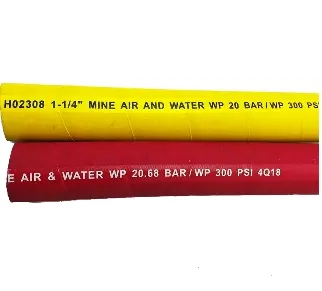335345435
Aug . 07, 2025 10:53 Back to list
Industrial Hose: Types, Applications, and Where to Find Reliable Suppliers
In heavy industry, manufacturing, construction, and logistics, the humble industrial hose does more than connect machinery. It carries everything from air and water to fuel, chemicals, abrasive media, food products, and high-temperature steam. The wrong hose choice can result in leaks, downtime, or even safety incidents—so choosing the right one is a mission-critical task.
Whether you're sourcing a specific industrial hose for sale, evaluating different specifications, or comparing industrial hose suppliers, this guide covers the essential types, applications, and pricing insights to help you make the right decision.

What Is an Industrial Hose?
An industrial hose is a flexible conduit designed to transport fluids, gases, or solids in demanding industrial environments. Unlike standard garden or utility hoses, industrial hoses are engineered for higher pressures, extreme temperatures, chemical compatibility, and mechanical stress.
Industrial hoses are used in:
Construction and mining
Petrochemical processing
Food and beverage plants
HVAC and water treatment
Marine and shipbuilding
Manufacturing and automation
Types of Industrial Hoses
There are dozens of hose types, each designed for specific materials, pressure ranges, and working conditions. Here’s a breakdown of the most common types of industrial hoses:
1. Air Hose
For pneumatic tools, compressors, and spray guns
Usually made of PVC, EPDM, or rubber
Pressure rated (150–300 PSI) and highly flexible
2. Water Discharge & Suction Hose
Moves large volumes of water for irrigation, pumping, or dewatering
Rubber or PVC with textile or steel reinforcement
Sizes range from 1" to 12"+ in diameter
3. Fuel & Oil Hose
Handles diesel, gasoline, kerosene, hydraulic oils
Inner lining made of nitrile rubber (NBR) or Viton
Often grounded to dissipate static electricity
4. Chemical Hose
Designed for highly corrosive acids, bases, solvents
Fluoropolymer or UHMWPE liners for chemical resistance
Must match the chemical compatibility chart
5. Steam Hose
Transfers saturated steam at high temperature and pressure
EPDM or chlorobutyl rubber, reinforced with braided wire
Rated for up to 450°F (232°C) and 250 PSI+
6. Food Grade Hose
For dairy, beverage, syrup, or edible oil transfer
Made from FDA-compliant materials (white EPDM, nitrile, or Teflon)
Odorless, tasteless, and easy to sanitize
7. Abrasive Material Hose
Used for sandblasting, concrete, or grain transfer
Reinforced with abrasion-resistant rubber or ceramic lining
Inner wall designed to handle particle wear
8. Ducting Hose
For air movement, fume extraction, or dust collection
Lightweight and flexible (often PVC, polyurethane, or silicone)
Can be compressible for storage
Each hose comes with its own fittings, coupling types, pressure ratings, bend radius, and temperature limits.
Key Specifications to Evaluate
Before purchasing an industrial hose, consider:
|
Specification |
Why It Matters |
|
Size (ID/OD) |
Must match your fittings and flow requirements |
|
Working pressure |
Rated in PSI or bar – critical for safety |
|
Temperature range |
Both ambient and internal fluid temps |
|
Material compatibility |
Hose lining must resist the material being transferred |
|
Reinforcement type |
Braided, spiral, or textile – affects flexibility and burst strength |
|
Certifications |
FDA, ISO, SAE, MSHA, or UL depending on industry |
Industrial Hose Prices: What to Expect
Industrial hose prices vary widely depending on type, size, and spec. Here's a rough estimate (USD/meter, 2025):
|
Hose Type |
Diameter |
Price Range (USD/meter) |
|
General air/water hose |
1/2"–1" |
$2.00 – $6.00 |
|
Fuel/oil hose |
3/4"–2" |
$5.00 – $12.00 |
|
Steam hose (250 PSI) |
1/2"–2" |
$10.00 – $25.00 |
|
Chemical hose (UHMWPE) |
1"–3" |
$12.00 – $35.00 |
|
Food-grade hose |
1"–4" |
$10.00 – $28.00 |
|
Abrasive material hose |
2"–6" |
$15.00 – $40.00+ |
Preassembled hoses with fittings (camlocks, flanges, quick-connects) may add $10–$50 per hose, depending on length and coupling type.
Choosing the Right Industrial Hose Supplier
A trustworthy industrial hose supplier should offer:
ISO or ASTM-certified products
Application-specific guidance (chemical resistance charts, pressure drop info)
Inventory availability for urgent orders
Custom assembly services
Transparent lead times and warranty policies
For regional markets, many certified OEMs in China, India, Germany, and the U.S. offer competitive pricing and rapid turnaround.
Industrial Hose FAQs
Q1: What’s the difference between braided and spiral hose reinforcement?
A: Braided hoses are more flexible and used for lower-pressure systems. Spiral-reinforced hoses are stiffer but can handle much higher pressure and burst resistance.
Q2: Can I use a water hose to transfer fuel?
A: No. Water hoses are not chemically resistant or pressure-rated for hydrocarbons. Always use fuel-rated hoses.
Q3: What certifications should food-grade hoses have?
A: Look for FDA, USDA, or 3A sanitary compliance, depending on your industry. Hose material should be non-toxic, odorless, and easy to clean.
Q4: Do industrial hoses come with fittings?
A: Not always. You can order bare hose by the meter, or request assemblies with specific fittings like camlocks, flanges, or quick-connects.
Q5: Where can I buy industrial hose in bulk or OEM?
A: Contact hose manufacturers directly or work with industrial distributors that offer OEM or private label options. Bulk orders often come on reels or pallets.
-
LPG Hose: Choosing the Right Hose for Safe, Reliable Gas Transfer
NewsAug.07,2025
-
Industrial Hose: Types, Applications, and Where to Find Reliable Suppliers
NewsAug.07,2025
-
Hydraulic Hose Pipe: Types, Pricing, and How to Source the Right One
NewsAug.07,2025
-
Hydraulic Fittings: Types, Customization, and Where to Source Them
NewsAug.07,2025
-
High Pressure Washer Hoses: Buying Guide, Specs, and Supplier Insights
NewsAug.07,2025
-
Choosing the Right Gasoline Hose: Flexibility, Resistance, and Supply Options
NewsAug.07,2025



